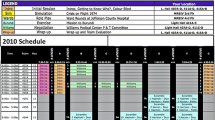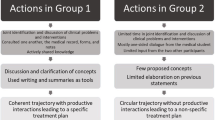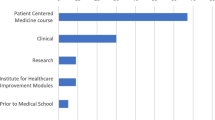Abstract
Communication errors between team members underlie many of the preventable patient errors within the US healthcare system. Medical students do not get the opportunity to take advantage of TeamSTEPPS® training because they are not consistently a part of hospital-based teams. Most of their communication skills training are focused on the doctor and patient relationship and less focus on teamwork (TW) skills. Developing TW skills earlier in medical education may help lead to better communication and patient safety; however, there is little time in preclinical medical education due to full curricula. The purpose of this study was to integrate TW skills development into existing physiology-based high fidelity patient simulations (HFPS) by using strategic triggers. A mixed-methods approach was used with the use of an evaluation tool and qualitative interviews to determine student perceptions of learning in these HFPS. Furthermore, since HFPS is costly in terms of faculty time, we aimed to find ways to reduce faculty time involvement. One hundred twenty first year medical students participated in three HFPS and observed one. The data show that TW skills are significantly improved between the first and last HFPS for most teams of students. There were no differences between learner-observer-led and faculty-led debriefs in development of TW skills. Qualitative student interviews show that they believe TW skills were learned by the HFPS and also that observing HFPS was beneficial in their learning. Overall, these data suggest that TW skills can be improved by integrating these into physiology-based HFPS with strategically placed triggers.



Similar content being viewed by others
References
To err is human: building a safer health system. Linda T. Kohn, Janet M. Corrigan, and Molla S. Donaldson, editors. National Academy Press, 2000. http://iom.nationalacademies.org/Reports/1999/To-Err-is-Human-Building-A-Safer-Health-System.aspx.
Clancy CM, Tornberg DN. TeamSTEPPS: assuring optimal teamwork in clinical settings. Am J Med Qual. 2007;22(3):214–7.
Cima RR, Kollengode A, Storsveen AS, Weisbrod CA, Deschamps C, Koch MB, et al. A multidisciplinary team approach to retained foreign objects. Jt Comm J Qual Patient Saf. 2009;35(3):123–32.
Awad SS, Fagan SP, Bellows C, Albo D, Green-Rashad B, De la Garza M, et al. Bridging the communication gap in the operating room with medical team training. Am J Surg. 2005;190(5):770.
Haig KM, Sutton S, Whittington J. SBAR: a shared mental model for improving communication between clinicians. Jt Comm J Qual Patient Saf. 2006;32(3):167–75.
Clancy CM. Ten years after To Err is Human. Am J Med Qual. 2009;24(6):525–8.
Morrison G, Goldfarb S, Lanken PN. Team training of medical students in the 21st century: would Flexner approve? Acad Med. 2010;85(2):254–9.
Lerner S, Magrane D, Friedman E. Teaching teamwork in medical education. Mt Sinai J Med. 2009;76(4):318–29.
Chakraborti C, Boonyasai RT, Wright SM, Kern DE. A systematic review of teamwork training interventions in medical student and resident education. J Gen Intern Med. 2008;23(6):846–53.
Association of American Medical Colleges. Medical simulation in medical education: results of an AAMC survey. September 2011.
Cronenwett L, Sherwood G, Barnsteiner J, Disch J, Johnson J, Mitchell P, et al. Quality and safety education for nurses. Nurs Outlook. 2007;55(3):122–31.
Hobgood C, Sherwood G, Frush K, Hollar D, Maynard L, Foster B, et al. Teamwork training with nursing and medical students: does the method matter? Results of an interinstitutional, interdisciplinary collaboration. Qual Saf Health Care. 2010;19(6), e25.
Salas E, Frush K. Improving patient safety through teamwork and team training. Oxford: Oxford University Press; 2012.
Harris DM, Bellew C, Cheng ZJ, Cendan JC, Kibble JD. High-fidelity patient simulators to expose undergraduate students to the clinical relevance of physiology concepts. Adv Physiol Educ. 2014;38(4):372–5.
Oriol NE, Hayden EM, Joyal-Mowschenson J, Muret-Wagstaff S, Faux R, Gordon JA. Using immersive healthcare simulation for physiology education: initial experience in high school, college, and graduate school curricula. Adv Physiol Educ. 2011;35(3):252–9.
Gordon JA, Oriol NE, Cooper JB. Bringing good teaching cases “to life”: a simulator-based medical education service. Acad Med. 2004;79(1):23–7.
Brown JF. Applications of simulation technology in psychiatric mental health nursing education. J Psychiatr Ment Health Nurs. 2008;15(8):638–44.
Bray BS, Schwartz CR, Weeks DL, Kardong-Edgren S. Human patient simulation technology: perceptions from a multidisciplinary sample of health care educators. Clin Simul Nurs. 2009;6(4):e145–e50.
Irby DM, Cooke M, O’Brien BC. Calls for reform of medical education by the Carnegie Foundation for the Advancement of Teaching: 1910 and 2010. Acad Med. 2010;85(2):220–7.
Adamson K. Integrating human patient simulation into associate degree nursing credentials. Clin Simul Nurs. 2010;6(3):e75–81.
Fountain RA, Alfred D. Student satisfaction with high-fidelity simulation: does it correlate with learning styles? Nurs Educ Perspect. 2009;30(2):96–8.
Miller A, Bull RM. Do you want to play? Factors influencing nurse academics’ adoption of simulation in their teaching practices. Nurse Educ Today. 2013;33(3):241–6.
Bloom BS. Taxonomy of educational objectives: the classification of educational objectives. Handbook 1: the cognitive domain. New York: McKay; 1964.
Bandura A. Social learning theory and personality development. New York: Rinerhart and Winston; 1963.
Wright MC, Taekman JM, Endsley MR. Objective measures of situation awareness in a simulated medical environment. Qual Saf Health Care. 2004;13 Suppl 1:i65–71.
Ostergaard HT, Ostergaard D, Lippert A. Implementation of team training in medical education in Denmark. Qual Saf Health Care. 2004;13 Suppl 1:i91–5.
Kutzin JM. Communication and teamwork focused simulation-based education for nursing students. Scholarworks@UMASS Amherst, 2010. http://scholarworks.umass.edu/cgi/viewcontent.cgi?article=1003&context=nursing_dnp_capstone
Dale E. Audiovisual methods in teaching. New York: Dryden Press; 1969.
Author information
Authors and Affiliations
Corresponding author
Electronic supplementary material
Below is the link to the electronic supplementary material.
ESM 1
(DOCX 19 kb)
Rights and permissions
About this article
Cite this article
Reinemann, J., LaBell, K., Bellew, C. et al. Integration and Improvement of Teamwork Skills in First Year Medical Students by Using Physiology-Based High Fidelity Patient Simulations. Med.Sci.Educ. 25, 503–512 (2015). https://doi.org/10.1007/s40670-015-0161-3
Published:
Issue Date:
DOI: https://doi.org/10.1007/s40670-015-0161-3




